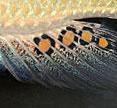The cichlids' egg-spots: How evolution creates new characteristics
The evolution of new traits with novel functions has always posed a challenge to evolutionary biology. Studying the color markings of cichlid fish, Swiss scientists were now able to show what triggered these evolutionary innovations, namely: a mobile genetic element in the regulatory region of a color gene. Their results have been published in the latest issue of the scientific journal Nature Communications. Biological evolution is in general based on the progressive adaption of traits through natural or sexual selection. However, ever so often, complex traits with completely new functions arise such as insect wings, feathers or the placenta. The evolution of such evolutionary innovations is often hard to explain relying solely on the model of progressive modification of already existing traits. Furthermore, it is largely unknown which genome modifications actually lead to evolutionary innovations.
A team of Basel researchers jointly lead by Prof. Walter Salzburger from the Department of Zoology and Prof. Markus Affolter from the Biozentrum at the University of Basel now clarified the genetic and developmental origins of an evolutionary innovation in African cichlids. The males of over 1,500 species feature conspicuous color markings on their anal fins -- so called egg-spots -- that play a central role in the mating behavior of these mouth-breeding fish. Immediately upon spawning, the female gathers up her eggs into the mouth before fertilization. The male then presents his egg-spots to which the female responds by snatching and bringing her mouth close to the male's genital opening -- only now are the eggs being fertilized inside the female's mouth.
Jumping genes
The Basel biologists were able to show that the evolution of egg-spots is linked to the insertion of a mobile genetic element -- a "jumping gene" -- in the regulatory region of a newly identified pigmentation gene. These mobile elements are short DNA strings that are able to change their position within the genome and can influence the regulation of other genes
In the case of the cichlid's egg-spots, the presence of the "jumping gene" upstream of a pigmentation gene with the name fhl2b leads to an alteration in gene expression in pigmentation cells and therefore to the development of the characteristic egg-spot pattern on the male cichlids' anal fin. The scientists came to this conclusion after having induced the cichlids' genome segment containing the mobile element into zebrafish embryos. In fact, they were able to locate the according expression in a specific group of pigmentation cells. "These results illustrate once more the importance of changes in gene expression in evolution," comments Prof. Walter Salzburger the findings.
Source: Universität Basel
Other sources
- Jumping Genes and Cichlids' Egg-Spots: How Evolution Creates new Characteristicsfrom Science DailyThu, 9 Oct 2014, 16:31:25 UTC
- The cichlids' egg-spots: How evolution creates new characteristicsfrom PhysorgThu, 9 Oct 2014, 14:30:39 UTC
